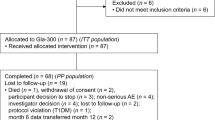Abstract
Patients’ perceptions of the extent to which their health care needs have been met may affect compliance with prescribed health behaviors and related health outcomes. The authors examined the relationships of “patient request fulfillment” to patient compliance, glycemic control, and several other health care outcomes in 51 adult outpatients with insulin-dependent diabetes mellitus. On average, patients retrospectively cited 4.5 long-term requests, of which over three-fourths were fulfilled. Fulfillment of these requests was significantly associated with patient satisfaction, perceived health status, fewer insulin reactions, and greater insulin injection time reliability (p<0.05), but not with several other measures of compliance. Higher patient request fulfillment at single visits was correlated, as hypothesized, with subsequent reduction in glycosylated hemoglobin, but this association was not statistically significant. These results suggest that patient request fulfillment is associated with several aspects of health behavior and health status in adults with insulin-dependent diabetes. Further studies are needed to confirm these observations and determine whether strategies to enhance patient request fulfillment can enhance health care outcomes.
Similar content being viewed by others
References
Lazare A, Eisenthal S, Wasserman L. The customer approach to patienthood: attending to patient requests in walk-in clinic. Arch Gen Psychiat 1975;32:553–8.
Speedling EJ, Rose DN. Building an effective doctor—patient relationship: from patient satisfaction to patient participation. Soc Sci Med 1985;21:115–20.
Levenstein JH, McCracken EC, McWhinney IR, Stewart MA, Brown JB. The patient-centred clinical method. 1. A model for the doctor—patient interaction in family medicine. Fam Pract 1986;3:24–30.
Lazare A, Eisenthal S. A negotiated approach to the clinical encounter. 1. Attending to the patient’s perspective. In: Lazare A, ed. Outpatient psychiatry. Baltimore: Williams and Wilkins, 1979;144–56.
Starfield B, Steinwachs D, Morris I, et al. Patient—doctor agreement about problems needing follow-up visit. JAMA 1979;242:344–6.
Greenfield S, Kaplan S, Ware JE. Expanding patient involvement in care: effects on patient outcome. Ann Intern Med 1985;102:520–8.
Uhlmann RF, Carter WB, Inui TS. Fulfillment of patient requests in a general medicine clinic. Am J Public Health 1984;74:257–8.
Glasgow RE, McCaul KD, Schafer LC. Self-care behaviors and glycemic control in type I diabetes. J Chronic Dis 1987;40:399–412.
Isaac S, Michael WB. Handbook in research and evaluation for education and the behavioral sciences. San Diego: EdITS, 1981;121–2.
Turkat ID. Diabetics’ self-report of medical utilization: a test of validity. Psychol Rep 1982;50:1160–2.
Linn MW, Linn BS, Harris R. The importance of self-assessed health in patients with diabetes. Diabetes Care 1980;3:599–606.
Inui TS, Jared RA, Carter WB, et al. Effects of a self-administered health history on new-patient visits in a general medicine clinic. Med Care 1979;17:1221–8.
Ware J, Snyder M. Dimensions of patient attitudes regarding doctors and medical care services. Med Care 1975;13:699–82.
Sackett DL. A compliance practicum for the busy practitioner. In: Haynes RB, Taylor DW, Sackett DL, eds. Compliance in health care. Baltimore: Johns Hopkins University Press, 1979;286–94.
Koenig RJ, Peterson CM, Jones RL, et al. The correlation of glucose regulation and hemoglobin A1 in diabetes mellitus. N Engl J Med 1976;295:417–20.
Fluckiger R, Winterhalter KH. In vitro synthesis of hemoglobin A1C. FEBS Lett 1976;71:356–60.
Parker KM, England JD, Da Costa J, et al. Improved colorimetric assay for glycosylated hemoglobin. Clin Chem 1981;27:669–72.
Pecoraro RE, Graf RJ, Halter JB, et al. Comparison of a colorimetric assay for glycosylated hemoglobin with ion-exchange chromatography. Diabetes 1979;28:1120–5.
Pecoraro RE, Koepsell TD, Chen MS, et al. Comparative clinical reliability of fasting plasma glucose and glycosylated hemoglobin in noninsulin-dependent diabetes mellitus. Diabetes Care 1986;9:370–5.
Uhlmann RF, Inui TS, Carter WB. Patient requests and expectations: definitions and clinical applications. Med Care 1984;22:681–5.
Good MD, Good BJ. Patient requests in primary care clinics. In: Chrisman NJ, Maretzki TW, eds. Clinically applied anthropology. Boston: D. Reidel, 1982;275–95.
Cohen J. A coefficient of agreement for nominal scales. Educ Psychol Measurement 1960;20:37–461.
Nie NH, Hull CH, Jenkins JG, et al. Statistical package for the social sciences. 2nd ed. New York: McGraw-Hill, 1975.
Cronbach LJ, Furby L: How we should measure “change”—or should we? Psychol Bull 1970;74:68–80.
Korsch BM, Gozzi EK, Francis V: Gaps in doctor—patient communication: 1. Doctor—patient interaction and patient satisfaction. Pediatrics 1968;42:855–71.
Eisenthal S, Emery R, Lazare A, et al. “Adherence” and the negotiated approach to patienthood. Arch Gen Psychiat 1979;36:393–8.
Sackett DL, Haynes RB, Tugwell P. Clinical epidemiology: a basic science for clinical medicine. Boston: Little, Brown, 1985;230–4.
Vinicor F, Cohen SJ, Mazzuca SA, et al. Diabeds: a randomized trial of the effects of physician and/or patient education on diabetes patient outcomes. J Chronic Dis 1987;40:345–56.
Greenfield S, Ware JE, Martin RA, Frank HJL. Expanded patient involvement in medical care: effects on blood sugar. Clin Res 1986;34:819A.
Author information
Authors and Affiliations
Additional information
Supported in part by the Northwest Health Services Research and Development Field Program, Seattle Veterans Administration Medical Center. Dr. Uhlmann was a Veterans Administration Fellow in the Robert Wood Johnson Clinical Scholars Program while working on this project and is the recipient of National Institute on Aging Academic Award K08 AG00265. The opinions expressed herein are those of the authors and not necessarily those of the Veterans Administration or the Robert Wood Johnson Foundation.
Rights and permissions
About this article
Cite this article
Uhlmann, R.F., Inui, T.S., Pecoraro, R.E. et al. Relationship of patient request fulfillment to compliance, glycemic control, and other health care outcomes in insulin-dependent diabetes. J Gen Intern Med 3, 458–463 (1988). https://doi.org/10.1007/BF02595922
Issue Date:
DOI: https://doi.org/10.1007/BF02595922




